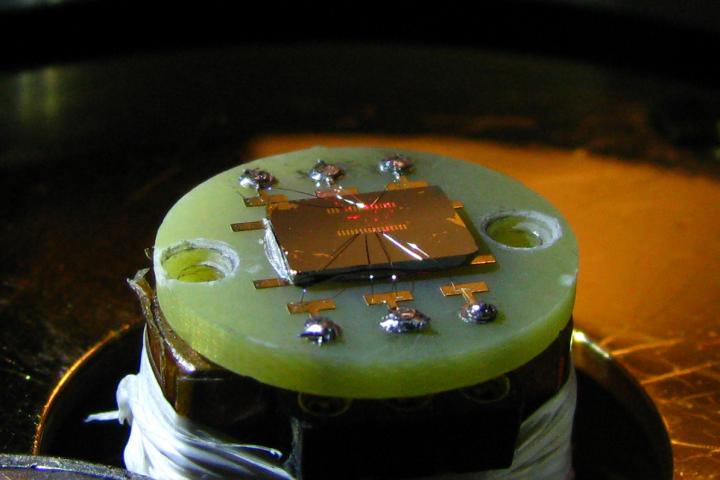Penn engineering research gives optical switches the 'contrast' of electronic transistors

Ritesh Agarwal's research on photonic computing has been focused on finding the right combination and physical configuration of materials that can amplify and mix light waves in ways that are analogous to electronic computer components. In a paper published in Nature Communications, he and his colleagues have taken an important step: precisely controlling the mixing of optical signals via tailored electric fields, and obtaining outputs with a near perfect contrast and extremely large on/off ratios. Those properties are key to the creation of a working optical transistor. Credit: Sajal Dhara
As fast and powerful as computers have become, Ritesh Agarwal, professor in the Department of Materials Science and Engineering in the University of Pennsylvania's School of Engineering and Applied Science, knows they could be more powerful. The field of photonic computing aims to achieve that goal by using light as the medium.
Agarwal's research on photonic computing has been focused on finding the right combination and physical configuration of materials that can amplify and mix light waves in ways that are analogous to electronic computer components.
In a paper published in Nature Communications, he and his colleagues have taken an important step: precisely controlling the mixing of optical signals via tailored electric fields, and obtaining outputs with a near perfect contrast and extremely large on/off ratios. Those properties are key to the creation of a working optical transistor.
“Currently, to compute '5+7,' we need to send an electrical signal for '5' and an electrical signal for '7,' and the transistor does the mixing to produce an electrical signal for '12,'” Agarwal said. “One of the hurdles in doing this with light is that materials that are able to mix optical signals also tend to have very strong background signals as well. That background signal would drastically reduce the contrast and on/off ratios leading to errors in the output.”
With background signals washing out the intended output, necessarily computational qualities for optical transistors, such as their on/off ratio, modulation strength and signal mixing contrast have all been extremely poor. Electric transistors have high standards for these qualities to prevent errors.
The search for materials that can serve in optical transistors is complicated by additional property requirements. Only “nonlinear” materials are capable of this kind of optical signal mixing.
To address this issue, Agarwal's research group started by finding a system which has no background signal to start: a nanoscale “belt” made out of cadmium sulfide. Then, by applying an electrical field across the nanobelt, Agarwal and his colleagues were able to introduce optical nonlinearities to the system that enable a signal mixing output that was otherwise zero.
“Our system turns on from zero to extremely large values, and hence has perfect contrast, as well as large modulation and on/off ratios,” Agarwal said. “Therefore, for the first time, we have an optical device with output that truly resembles an electronic transistor.”
With one of the key components coming into focus, the next steps toward a photonic computer will involve integrating them with optical interconnects, modulators, and detectors in order to demonstrate actual computation.
###
Agarwal Lab members Ming-Liang Ren, Jacob S. Berger, Wenjing Liu and Gerui Liu all contributed to the research.
This research was supported by the US Army Research Office through grants W911NF-11- 1-0024 and W911NF-12-R-0012-03, and the National Science Foundation through a Materials Research Science and Engineering Center seed grant, award number DMR11-20901. Nanofabrication and electron microscopy characterization was carried out at Penn's Singh Center for Nanotechnology.
Media Contact
All latest news from the category: Power and Electrical Engineering
This topic covers issues related to energy generation, conversion, transportation and consumption and how the industry is addressing the challenge of energy efficiency in general.
innovations-report provides in-depth and informative reports and articles on subjects ranging from wind energy, fuel cell technology, solar energy, geothermal energy, petroleum, gas, nuclear engineering, alternative energy and energy efficiency to fusion, hydrogen and superconductor technologies.
Newest articles

Combatting disruptive ‘noise’ in quantum communication
In a significant milestone for quantum communication technology, an experiment has demonstrated how networks can be leveraged to combat disruptive ‘noise’ in quantum communications. The international effort led by researchers…

Stretchable quantum dot display
Intrinsically stretchable quantum dot-based light-emitting diodes achieved record-breaking performance. A team of South Korean scientists led by Professor KIM Dae-Hyeong of the Center for Nanoparticle Research within the Institute for…

Internet can achieve quantum speed with light saved as sound
Researchers at the University of Copenhagen’s Niels Bohr Institute have developed a new way to create quantum memory: A small drum can store data sent with light in its sonic…





















